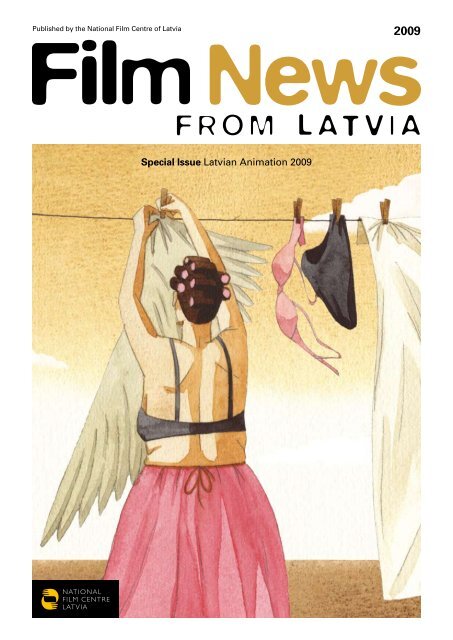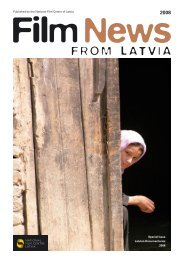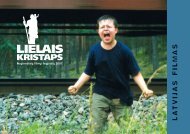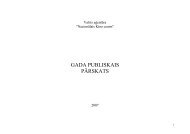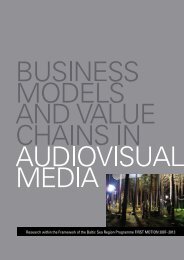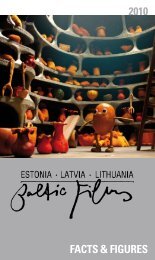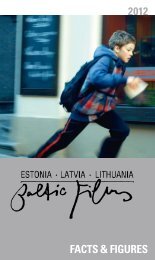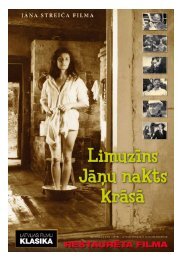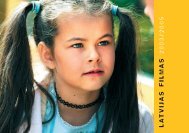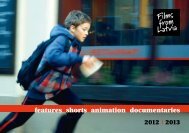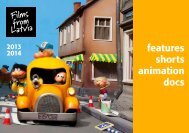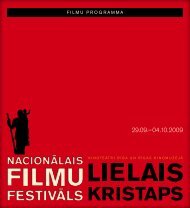Latvian Animation - NacionÄlais Kino centrs
Latvian Animation - NacionÄlais Kino centrs
Latvian Animation - NacionÄlais Kino centrs
Create successful ePaper yourself
Turn your PDF publications into a flip-book with our unique Google optimized e-Paper software.
Published by the National Film Centre of Latvia<br />
2009<br />
FROM LATVIA<br />
Special Issue <strong>Latvian</strong> <strong>Animation</strong> 2009
LATVIAN<br />
ANIMATION<br />
CONTENTS<br />
Special Issue<br />
<strong>Latvian</strong><br />
<strong>Animation</strong><br />
2009<br />
Front Cover Wings and Oars<br />
Editor Zigita Saulīte<br />
Text Kristīne Matīsa, Zane Dzene, Agnese Surkova<br />
Contributors Līga Miezīte Jensena, Lelda Ozola<br />
Language Editor Sarma Māra Gaide<br />
Design and Layout Arnis Grinbergs<br />
Photos Agnese Zeltiņa and from the archive of the National Film Centre of Latvia<br />
Printer Apgāds Imanta<br />
© National Film Centre of Latvia and Media Desk Latvia, 2009<br />
2 2<br />
FN | 1
Kristīne Matīsa<br />
Editor, Film Magazine <strong>Kino</strong> Raksti<br />
Vladimir Leschiov.<br />
Some Notes on<br />
<strong>Animation</strong>.<br />
Although the producer,<br />
director and animator<br />
of the studio Lunohod,<br />
Vladimir Leschiov, has<br />
worked professionally<br />
in animation only since<br />
2004, all of his five films have received a<br />
lot of acclaim on the international film<br />
festival circuit. Vladimir Leschiov’s films<br />
can be described as philosophical, visually<br />
exquisite, poetic and with a surreal<br />
touch. His first two films, The Letter and<br />
Grandad’s Honey, were created while<br />
studying animation in Sweden in 2002.<br />
Both next, professional animated short<br />
films, Insomnia and Lost in Snow, were<br />
screened at a record number of festivals<br />
(the latter has been screened at about 70<br />
festivals!) collecting several awards. His<br />
latest film, Wings and Oars, has been<br />
included in the official program of short<br />
animation films at the prestigious Annecy<br />
<strong>Animation</strong> Festival 2009. Celebrating<br />
this achievement we invited the<br />
director to a conversation, resulting in<br />
these notes.<br />
Annecy and<br />
other festivals<br />
The Annecy festival for animators is<br />
the same as Cannes is for features. Yes,<br />
it’s relevant for me, not as sport, but<br />
because it really is the most relevant<br />
festival and an achievement. I can’t really<br />
determine how deserving my film<br />
Spārni un Airi (Wings and Oars) is to be<br />
included in the competition, because<br />
any festival is a lottery and the jury is<br />
made up of the most diverse people.<br />
I’ll say this though, I’m much more<br />
satisfied with Spārni un Airi compared<br />
to previous films – not completely, of<br />
course, but still. When I finished editing<br />
and took a look, I watched it with<br />
great pleasure, and any doubts about<br />
using such an unpredictable medium –<br />
watercolour - disappeared.<br />
Hiroshima is the second largest animation<br />
festival in the world – when I<br />
was studying and making my first film,<br />
I could only dream of showing my<br />
work at that festival. And look, Vectēva<br />
medus (Grandad’s Honey) made it into<br />
two of Hiroshima’s competition programs<br />
in the first year, one for students<br />
and the main one. Two years later Bezmiegs<br />
(Insomnia) was in competition<br />
and won an award, and after two more<br />
years Zuduši sniegā (Lost in Snow)<br />
was again in competition and won an<br />
award. If you consider that the Hiroshima<br />
festival takes place every two years,<br />
I receive an award each time! I joke<br />
with my friends – maybe the Japanese<br />
really love me. I’ve read a lot about the<br />
East and still have great interest, so<br />
perhaps they feel that.<br />
Being at the festivals is a great opportunity<br />
to find partnerships for the<br />
future if I decide to work on a serious<br />
project, moreover, my participation<br />
is great baggage – if I decide to work<br />
with someone and he asks who I am, I<br />
have only to show my CV, and all will<br />
be clear.<br />
But the most important thing is to see<br />
good films and meet people who have<br />
made the films, to discover what they<br />
think and how they work. If you don’t<br />
see the director and don’t find out<br />
anything about him, that lowers the<br />
festival’s level.<br />
On animation:<br />
the author’s signature<br />
and animation<br />
technology<br />
I would, of course, like to create my own<br />
signature and recognizable style, but<br />
somehow it hasn’t worked out. When I<br />
think about a new story, technology is<br />
one of the most important factors for<br />
me that determines the rest of it. If I<br />
don’t feel the plot in pencil, I must go to<br />
watercolour, and vice versa. Secondly,<br />
and what’s also interesting for me –<br />
there are so many techniques in the<br />
world, so why shouldn’t I try something<br />
new? I like to experiment, and my signature<br />
can be recognized elsewhere – in<br />
the film’s language and plot.<br />
There is an episode in each of my films<br />
that wasn’t planned on at first concept<br />
and framing. Sometimes the film is<br />
finished and I look at it and see – ah, I<br />
need something like this here…In the<br />
film Zuduši sniegā the episode was the<br />
moment when the man throws off the<br />
coat and jumps into the water, and in<br />
Bezmiegs it was when the woman appears<br />
in the window…It’s like preparing<br />
food – it’s ready, you taste it, but<br />
think it still needs something else...you<br />
rummage through the spice rack and<br />
suddenly find the right pepper!<br />
I don’t agree with the idea that a film<br />
needs only one main character – every<br />
good film has to have at least one<br />
character that appears, disappears, and<br />
we don’t know anything about him -<br />
it’s Fellini’s finest trick. If you’re filming<br />
on the street, then the usual way is to<br />
seal the whole block off with police<br />
tape, have actors in all the windows,<br />
and lock the doors so that there are no<br />
mishaps – we’re filming! But in a Fellini<br />
film, suddenly, calmly, in the middle<br />
of a scene, a second storey window<br />
flies open and a rotund Italian woman<br />
shakes out her enormous drawers,<br />
fastens them to the laundry line and<br />
shuts the window. And that lends<br />
credibility to the rest of what happens<br />
in the scene, that’s Fellini’s realism.<br />
<strong>Animation</strong> brings everything to life<br />
– old photographs, interviews, drawings…but<br />
it isn’t anything radical – it’s<br />
simply one of the ways it can be done.<br />
And documentary animation is actually<br />
an even easier method – if you have,<br />
for example, old albums with photos<br />
or drawings, you already have a readymade<br />
film setting and a world that<br />
doesn’t have to be constructed from<br />
scratch, just brought to life. But when<br />
you start from zero with a storyboard<br />
and frames, you have to depict each<br />
detail of a completely new world that<br />
Wings and Oars<br />
hasn’t previously existed, only in your<br />
fantasy, and that is a very lengthy and<br />
serious process.<br />
I don’t see how 3D animation can develop.<br />
You can experiment with other<br />
animation methods and figure out new<br />
ways, but with this it isn’t possible –<br />
your new animation medium is your<br />
newest super computer, and you have<br />
to buy an even newer and better one<br />
next year. That’s simply the development<br />
of equipment, not animation.<br />
Okay, you’ll have even more perfect<br />
lighting and precise movement, and<br />
finally we won’t be able to tell the difference<br />
between 3D animation and<br />
reality – but what’s the point?! A few<br />
years ago the Americans said – it’s going<br />
to be great, soon we won’t have to<br />
pay actors huge salaries, we can make<br />
anything in 3D. But who will want to<br />
watch something synthetic with no life?<br />
Schools of Art<br />
and Life<br />
At this point I’m more or less trying to<br />
forget everything I learned at the Jānis<br />
Rozentāls Art School, because sometimes<br />
when I draw something freely as<br />
I feel it, the knowledge slowly starts to<br />
creep in, and it ends up being too correct.<br />
I feel an image and I know how<br />
it should move, but knowledge of correct<br />
proportions messes about in my<br />
head… I can animate any image, even<br />
those that don’t exist in reality; I know<br />
what the internal skeleton is or should<br />
be. But sometimes I need to work freely,<br />
and it’s not easy.<br />
When I finished school, my teacher<br />
said that I would definitely get into the<br />
graphics department at the Art Academy<br />
of Latvia. After the entrance exams<br />
– never in my life have I’ve been as sure<br />
of something as when I went to see my<br />
results. I was sure I was in, but when<br />
I saw the results…at first I thought it<br />
was a mistake, and at that time it only<br />
meant one thing – off to the army. I<br />
went to the enlistment office and the<br />
officer was gleeful – so Leschiov, didn’t<br />
get in? Here you go – Severnij flot in<br />
Murmansk…I didn’t serve the whole<br />
three years though, as it was the end of<br />
the 80s and they let us go home after<br />
two. I returned, no one needed me, and<br />
I had forgotten how to draw…I worked<br />
in advertising for a time and made the<br />
first 3D graphics even though I didn’t<br />
know anything about computers. And<br />
so I worked and worked, going from<br />
FN | 2<br />
2<br />
FN | 3
Vladimir Leschiov. Some Notes on <strong>Animation</strong>.<br />
Photo: A. Zeltiņa<br />
job to job, company to company, collecting<br />
experience and growing.<br />
In the mid-90s I began exploring animation,<br />
trying out plasticine, using<br />
a computer, and found I really liked<br />
doing it. I began pitching animation<br />
for ads – if a client let me I made an<br />
animated clip, but I soon understood<br />
that I was subjected to other’s tastes<br />
– to what the agency and the client<br />
wanted…I wanted to do my own thing<br />
and had already started making a film<br />
during my free time. After a while I<br />
knew I would never finish the film this<br />
Vladimir<br />
Leschiov<br />
Vladimir Leschiov was born in 1970.<br />
He finished the Jānis Rozentāls Art<br />
School in Riga in 1989, and studied<br />
animation at Konstfack University<br />
College of Arts, Crafts and Design in<br />
Sweden. Since 1992 he has worked as<br />
an illustrator, designer and art director<br />
on commercials in Latvia. From 2004 he<br />
has worked professionally in animation,<br />
and since 2005 he teaches animation<br />
at the Art Academy of Latvia. After<br />
working at the larger <strong>Latvian</strong> animation<br />
studios - Rija Films and Jet Media – he<br />
established his own animation studio,<br />
Lunohod, in 2007.<br />
Filmography:<br />
Wings and Oars, 2009<br />
Lost in Snow, 2007<br />
Insomnia, 2004<br />
Grandad’s Honey, 2002<br />
The Letter, 2002<br />
way, so I had to decide what I really<br />
want – to work in advertising or make<br />
films. There are a lot of people like<br />
that in advertising – they really want to<br />
make films and say, that’s it, one last ad<br />
and I’m off to write a script. And they<br />
say that every day for years!<br />
It took quite a while for me and it was<br />
even a bit painful, because once a decision<br />
like that is made, suddenly there<br />
is no more income. But finally I started<br />
looking for a school where I could learn<br />
animation – one not too far away and<br />
where I didn’t have to pay. I found a<br />
school in Sweden where I was accepted<br />
into the graduate program right away<br />
because I had submitted my work – the<br />
ads, the clips, my own attempts…<br />
It’s better to work in my home country;<br />
I’ve tested this out. In Sweden I<br />
didn’t have to worry about the lack of<br />
anything – if you don’t have the right<br />
pencil, sign up and the next morning<br />
you’ll receive a packet of pencils,<br />
nicely wrapped, inscribed with your<br />
last name and a smiley face…Here you<br />
have to fight for every pencil, but even<br />
so it’s more interesting. That’s why I<br />
like it in Latvia – everything here is absurd<br />
and illogical, that’s why foreigners<br />
think my films are strange, but I’m not<br />
making it up, I show it like it is. I don’t<br />
feel as good in Sweden or Germany because<br />
everything there is clear, logical,<br />
and too correct.<br />
His Own Studio –<br />
There are many reasons why I can’t<br />
work in someone’s studio. I’m a huge<br />
egoist in regards to my work, and if I’m<br />
doing a project, it’s important that the<br />
very best people with the most serious<br />
attitude are involved. And in big<br />
studios three or four projects are going<br />
in parallel, and if the situation on one<br />
suddenly becomes intense, then the<br />
best people are mobilized for that one<br />
project and the others almost stop. It’s<br />
very disruptive and doesn’t benefit any<br />
of the projects. An animator is an actor<br />
who has to grow into a character until<br />
he knows it and feels it completely. If<br />
he’s suddenly yanked away and put<br />
into a different character, and then<br />
released after two months, he has, in<br />
the meantime, forgotten the feel of my<br />
film and time is wasted reviving that. It<br />
isn’t normal, it’s not the way to work, at<br />
least not for me. I’m the king and dictator<br />
where I work, that’s just how it is.<br />
I spent a long time thinking about<br />
a name for my studio – I couldn’t<br />
use my last name as it’s difficult for<br />
foreigners to say. I knew I needed<br />
something not from this world. I was<br />
born in 1970, right when the lunohod<br />
landed on the Moon (in 1970 the Soviet<br />
lunar-rover Lunohod-1 landed on<br />
the surface of the Moon – ed.)<br />
I’ve heard talk that Lunohod is one of<br />
the biggest studios in the Baltics, and I<br />
also read in a serious animation portal<br />
that Vladimirs Leschiov has established<br />
his own studio. Someone is obviously<br />
following what I’m doing, and<br />
it’s really interesting to discover that<br />
– almost like standing behind a door<br />
and listening to what others are saying<br />
about you. That’s what happened during<br />
Bezmiegs when I was still unknown<br />
at the festivals – I’m standing beside<br />
a famous French director who says to<br />
his colleague that Bezmiegs is a very<br />
interesting film, fresh and new, but<br />
the director must be on some kind of<br />
drugs…And literally a few hours later<br />
someone introduced us and then he<br />
felt a bit uncomfortable because he<br />
had seen me earlier, and I told him I<br />
don’t do drugs…<br />
Future <strong>Animation</strong><br />
Projects<br />
I think I could make a feature-length<br />
animation film at some point, a series,<br />
or animation for children, but I’m<br />
not ready yet, as, truthfully, it’s a very<br />
serious undertaking. There’s no point<br />
in making a feature-length film that<br />
isn’t commercially viable; it’s too big a<br />
project to fool around with.<br />
If someone asks why I don’t make<br />
films for children, the only answer is<br />
– it’s the most serious audience. It’s<br />
not as risky making films for adults,<br />
but children perceive the world very<br />
deeply and directly, and that’s a<br />
huge responsibility. The other thing<br />
is that children now are different<br />
than we were, and they know and<br />
have experienced much more. That’s<br />
why creating stories for them about<br />
bears and foxes is no longer relevant<br />
– they know a different world, of robots,<br />
killers and ninjas. I’m not really<br />
interested in working with foxes<br />
or killers, and I’ve yet to discover a<br />
world I want to show children. That’s<br />
why I’m doing more passive exploration<br />
now and looking at what might<br />
work in the future.<br />
FN | 4 FN | 5
Agnese Surkova, Film Critic<br />
<strong>Latvian</strong> <strong>Animation</strong><br />
RIJA<br />
DAUKA<br />
■ In spite of the hard times, one of<br />
Latvia’s oldest and most experienced<br />
animation film studios, Dauka, has kept<br />
up its fine spirit and resilience. Established<br />
in 1969 by Roze Stiebra and Ansis<br />
Bērziņš, the studio’s contribution to<br />
<strong>Latvian</strong> animation is already considered<br />
part of cultural heritage.<br />
Just recently, studio Dauka’s animators,<br />
overseen by Roze Stiebra and<br />
Ansis Bērziņš, finished eight months<br />
of work on their latest film. 2D animation<br />
film Dzeguze un viņas 12 vīri<br />
■ Studio Rija Films animators are<br />
always busy and the activity is noticeable<br />
enough that the phrase “economic<br />
crisis” doesn’t seem to apply. Founded<br />
in 1995, Rija, perhaps the best<br />
internationally-known <strong>Latvian</strong> film<br />
studio, keeps making co-productions,<br />
and is currently working on two new<br />
features. Continuing their successful<br />
collaboration with the Estonian studio<br />
Joonisfilm, Rija promises, in the next<br />
year, to release the continuation of the<br />
adventures of much loved puppy-girl<br />
Lotte, in the animation film Lote un<br />
Mēness akmens noslēpums (Lotte and<br />
the Moonstone Secret). A few intriguing<br />
plot secrets have come to light –<br />
Lotte and her friends will meet some<br />
unknown Moon dwellers, and the film<br />
will feature at least two new songs from<br />
the band Prāta Vētra (Brainstorm).<br />
Immediately after Lotte, the next<br />
project will be an animated version of<br />
the play Zelta Zirgs (Golden Horse) by<br />
Jānis Rainis, meant for the whole family.<br />
Producer Vilnis Kalnaellis anticipates<br />
that Zelta Zirgs (MEDIA Development<br />
Support) will be a feature-length<br />
animation that fits with Rija’s internationally<br />
recognized image: national<br />
in content, international in form. On<br />
board is director Signe Baumane who<br />
has worked for many, creatively-rich<br />
years in the US, and Xavier Dujardin, a<br />
character artist from Belgium, who is<br />
lesser known to <strong>Latvian</strong> viewers.<br />
Even though Rija Films has had<br />
plenty of success in international coproductions,<br />
there is also a bounty of<br />
home-grown animation in its wings. The<br />
beginning of 2009 saw the international<br />
premiere of Reinis Kalnaellis’ debut film<br />
Kad āboli ripo (When Apples Roll) at the<br />
59 th Berlinale film festival, and just now<br />
in April, the 2D animation film did the<br />
rounds of six international festivals – in<br />
Greece, Germany, the USA, Turkey, Italy<br />
and here in Latvia, at the Berimora kino<br />
festival. In addition, the film has received<br />
an invitation to participate in France’s<br />
Annecy Plus, founded by Bill Plympton.<br />
With positive reviews, an abundance of<br />
ideas and zeal, there’s no standing still;<br />
Vilnis Kalnaellis thinks that work will<br />
soon begin on another new animation<br />
film - a sequel to Kad āboli ripo, but this<br />
time in feature length.<br />
Working at the same pace as till<br />
now, studio Rija hopes to finish two<br />
more <strong>Latvian</strong> animation films by the<br />
fall. Viewers will first be offered a 3D<br />
(The Cuckoo and her 12 Hubbies), is a<br />
comic story with Pēteris Brūveris’ poetry<br />
about Dzeguze’s romantic adventures.<br />
Through Roze Stiebra’s direction and<br />
her screenplay, Dzeguze is full of rich,<br />
colourful visual imagery created by artist<br />
Gundega Muzikante, with an equally<br />
colourful original score by composer<br />
Mārtiņš Brauns.<br />
The studio’s founders would be<br />
happy to accept new professionals into<br />
their small, experienced collective,<br />
and in order to train skilled animators<br />
they’ve organized year-long courses for<br />
five promising youths. Roze Stiebra emphasizes<br />
that Dauka is a workshop type<br />
of studio – small, open to creative ideas,<br />
animation, Skatu meklētājs (View Finder),<br />
by Pēteris Noviks, a story about<br />
a blind person’s insights and radiant<br />
daydreams while waiting for the green<br />
light at a crossing. Soon after that, the<br />
2D animation, Norīt krupi (To Swallow<br />
a Toad), will be ready, and directorartist<br />
Jurģis Krāsons’ signature will now<br />
be in colour [his 2006, internationally<br />
recognized animation film, Melnā kaste<br />
(Black Box), was in black & white].<br />
Not waiting on the creation of an<br />
animation school in Latvia, the studio<br />
organizes animation courses on its<br />
own, and helps young artists in their<br />
craft. Vilnis Kalnaellis promises that<br />
Rija will continue to provide opportunities<br />
for the expression of animation<br />
ideas that are new, original, and able<br />
to compete internationally – some of<br />
those will take shape very soon.<br />
Golden Horse<br />
and willing to train those interested.<br />
And as the fall will once again be busy<br />
– financing for a new animation film<br />
was granted by the State Culture Capital<br />
Foundation – one of the upcoming animators<br />
will have a chance to show their<br />
skills. Roze Stiebra’s assistant on her<br />
latest project is Miks Straume, a student<br />
from the Baltic International Academy.<br />
Inga Actiņa, whose drawings the director<br />
characterizes as spirited caricatures,<br />
will be the film’s artist. Pre-production<br />
has begun, and the studio promises to<br />
showcase a new and thrilling 2D animation<br />
film - Kā brālītis trusītis uzvarēja<br />
lauvu (Brer Rabbit and Boss Lion). This<br />
will be the fourth story in the Dauka<br />
ANIMĀCIJAS<br />
BRIGĀDE<br />
■ The studio that is continuing the<br />
tradition of animation master Arnolds<br />
Burovs’ puppet film studio founded in<br />
1966, currently has more than ten associates.<br />
The small collective will soon<br />
finish work on two new puppet animation<br />
films. Soon too, sound will be<br />
added to the 35mm film Cūkas laime<br />
(Pig’s Happiness), by director Dace<br />
Rīdūze and artist Ieva Kauliņa - a jolly<br />
story about a city pig family’s vacation<br />
in the countryside.<br />
Master of Ice<br />
JURIS PODNIEKS<br />
STUDIO<br />
■ STUDIJA CENTRUMS and the producer<br />
Bruno Aščuks have begun their<br />
activities by releasing the first ever<br />
<strong>Latvian</strong> documentary animation Little<br />
Bird’s Diary – an exceptional life story<br />
told through animated drawings of<br />
the main character – 80 years old Irina<br />
Piļķe. Another docu-animation is in the<br />
pipeline – this time based on the drawings<br />
from exile in Siberia.<br />
Studio JET MEDIA is developing<br />
a series of 2D/3D animation Tales of<br />
the Sunrise Tree (MEDIA Development<br />
Support and co-production with Slovenia).<br />
Another series by this company<br />
Weasymartenette has also got MEDIA<br />
Development Support and is in an<br />
early development stage.<br />
SIGNE BAUMANE, the internationally<br />
acknowledged <strong>Latvian</strong> animation<br />
film director, Member of the American<br />
Motion Pictures Association, is working<br />
By mid 2009, the studio also plans<br />
to finish director Ēvalds Lācis’ newest<br />
achievement – a magical story about<br />
love and saving a princess, called Ledus<br />
pavēlnieks (Master of Ice). Jānis Cimermanis,<br />
one of the film’s animators,<br />
tells us that the story will have many<br />
visually impressive marvels that computer<br />
artist Andris Gailītis is helping to<br />
create. As soon as the digital processing<br />
of the film is done, composer Juris Kulakovs<br />
will begin his work.<br />
Animācijas Brigāde is currently<br />
preparing for a large-scale co-production<br />
project – the shooting of the<br />
feature-length film Mežonīgie pīrāgi<br />
(The Wild Pirogi), (MEDIA Development<br />
Support). The screenplay author<br />
and artist is Māris Putniņš, with director<br />
Jānis Cimermanis, who reveals<br />
that 20 dolls have already been made<br />
for the film, and a 3 minute film clip<br />
will be finished shortly. He added that<br />
Mežonīgie pīrāgi will be a romantic,<br />
adventure-filled pirate story with a<br />
happy ending, but it won’t be the end<br />
of the adventures of the pīrāgi – the<br />
■ The heart and soul of animation<br />
at the Juris Podnieks Studio is Nils<br />
Skapāns. One of the most notable international<br />
achievements of Nils Skapāns’<br />
claymation films was the Crystal Bear at<br />
the Berlinale for the 1994 film Lidojam?!<br />
(Let’s Fly?!). Ten years later, his film,<br />
Redzi, Trusi…Tētis brauc uz Londonu<br />
(Listen, Rabbit…Daddy Goes to London,<br />
2004) was again screened at the<br />
Berlin film festival.<br />
The studio is currently creating<br />
a claymation mischief and adventure<br />
story about a day in the life of a<br />
nasty lady and her cat – Burvīga diena<br />
(Wonderful Day). The artist, helped on<br />
occasion by puppet artist Ilze Esme,<br />
hopes to finish this 15 minute film by<br />
the end of 2009.<br />
Parallel to this project, Nils<br />
Skapāns is also making claymation<br />
episodes for Pēteris Krilovs’ latest<br />
documentary, Lietus un vēji.<br />
both in Latvia and the US. Signe’s latest<br />
animation Birth has experienced its<br />
world premiere nominated for the Best<br />
Short Film at the Berlin International<br />
Film Festival 2009 and is now on its way<br />
to be screened at the Anncey Film Festival.<br />
In the meantime, Signe is working<br />
on the feature animation Golden Horse<br />
at studio Rija Films in Riga.<br />
There is a lot of production activity<br />
taking place at other animation<br />
studios as well. Studio URGA has previously<br />
produced two of director, artist<br />
and animator Kārlis Vītols’ animation<br />
films, Mehānisms (Mechanism) and<br />
Trofeja (The Trophy), and have now<br />
released an ironic, visually interesting<br />
and attractively narrated animation<br />
film, Velna Fudži (Devil’s Fuji). Several<br />
new animation films in collaboration<br />
with well-known <strong>Latvian</strong> animation<br />
directors are in the making at studio<br />
<strong>Latvian</strong> <strong>Animation</strong><br />
Coming Soon<br />
Lote un Mēness akmens noslēpums<br />
Lotte and the Moonstone Secret Rija<br />
Skatu meklētājs View Finder Rija<br />
Norīt krupi To Swallow a Toad Rija<br />
Sarkanais jātnieks Red Rider RIJA<br />
Austras koka pasakas<br />
Tales of the Sunrise Tree JET MEDIA<br />
Kā brālītis trusītis uzvarēja lauvu<br />
Brer Rabbit and Boss Lion<br />
Dauka<br />
Cūkas laime Pig’s Happiness<br />
Animācijas Brigāde<br />
Ledus pavēlnieks Master of Ice<br />
Animācijas Brigāde<br />
Burvīga diena Wonderful Day<br />
Juris Podnieks Studio<br />
Reiz Dievs... Once Upon a Time God ...<br />
Atom Art<br />
Lupatiņi Shammies Atom Art<br />
Pavasaris Vārnu ielā<br />
Springtime on Vārnu Street<br />
Atom Art<br />
Sieviete un Vējš Women and Wind<br />
A.Bley Film Studio<br />
ATOM ART. Māra Liniņa is working on<br />
a three-part animation series based<br />
on <strong>Latvian</strong> folklore on how the world<br />
was created: Reiz Dievs…(Once Upon a<br />
Time God…). Edmunds Jansons is directing<br />
two films: Lupatiņi (Shammies)<br />
and Pavasaris Vārnu ielā (Springtime<br />
on Vārnu Street). The last is a musical<br />
animation about the adventures of the<br />
children of a working-class family in<br />
19 th century Riga. Director Aija Bley has<br />
her own studio, A. BLEY FILM STU-<br />
DIO, and her latest project is an animation<br />
short, Sieviete un Vējš (Women<br />
and Wind), together with recognized<br />
artist Patrīcija Brekte - a poetic story<br />
of passionate love between a Western<br />
Woman and an Eastern Wind.<br />
It is certain that viewers both here<br />
at home and those abroad will soon get<br />
to experience a new and rich crop of<br />
<strong>Latvian</strong> animation!<br />
FN | 6 FN | 7
Zane Dzene, Film Critic<br />
Defining Moments in<br />
<strong>Latvian</strong> <strong>Animation</strong><br />
Notable animation films in <strong>Latvian</strong> film history<br />
1966 Ki-ke-ri-gū! The Cock’s Crow<br />
■ Ki-ke-ri-gū! is the first <strong>Latvian</strong> animation film. The director, Arnolds Burovs, is<br />
already well-known in <strong>Latvian</strong> culture circles, having secured a spot in the <strong>Latvian</strong><br />
theatre Olympus with achievements<br />
in puppet theatre. At the age of 50, he<br />
begins to create….animation! Burovs is<br />
the father of <strong>Latvian</strong> animation, and his<br />
traditions are now carried on by studio<br />
Animācijas Brigāde. The director’s filmography<br />
includes both <strong>Latvian</strong> folk<br />
story themes as well as classics of world<br />
literature.<br />
1969 Lietainā diena<br />
Rainy Day<br />
■ Animators at <strong>Latvian</strong> Television get<br />
into the game, and Roze Striebra, an<br />
actress from the puppet theatre together<br />
with documentary film maker and<br />
cinematographer, Ansis Bērziņš, create<br />
the first film using applique technique.<br />
This successful collaboration will later<br />
become the animation studio Dauka,<br />
with traditions focused on <strong>Latvian</strong> folklore,<br />
poetic rhythm and sincerity.<br />
1976 Caps meklē<br />
Caps in Pursuit<br />
■ Puppet master Arvīds Noriņš creates<br />
a detective story for children in a James<br />
Bond mode, solving tricky secrets one<br />
after the other. Remaining aware of his<br />
young and demanding audience, a large<br />
role is given to communism, so that the<br />
educational aspect isn’t lost, of course.<br />
1974 Dillī Dallī Perpendikula valstībā<br />
Dilly Dally in Perpendicular’s Kingdom<br />
■ The first series (films made in 1974, 1975 and 1976) in <strong>Latvian</strong> animation history,<br />
in which good and bad characters are clearly defined, and there is a special emphasis<br />
on the accompanying sound. Perpendikuls, created by artist Daina Lapiņa,<br />
becomes a scary ghost-image for young viewers!<br />
1977 Si-Si-Dra<br />
■ Thanks to Arnolds Burovs’ farsightedness,<br />
some notable caricaturists<br />
arrive at Riga Film Studio, and one of<br />
them, Gunārs Bērziņš, is responsible for<br />
this jolly film’s visual image and playfully<br />
instructional tone. The kids like<br />
it and the adults are happy that their<br />
offspring were now clear on why it’s bad<br />
to act like a pig in the forest, and what<br />
happens if one should be a “pig”.<br />
1967 Pigmalions<br />
The Pygmalion<br />
■ The legendary story is successfully<br />
re-created in the hands of Riga<br />
Film Studio director Arnolds Burovs.<br />
Though the film’s fate in Latvia is<br />
complicated, Moscow officials proudly<br />
screen it for foreign delegations, saying,<br />
look, we have modernism, symbolism<br />
and abstractionism in the Soviet<br />
Union as well…<br />
1978 Vanadziņš The Hawk<br />
■ Undoubtedly one of the all-time most beautiful <strong>Latvian</strong> animation films - the<br />
screenplay is based on themes from the stories of writer Vilis Lācis, and depicts the<br />
relationship between a small boy and<br />
his father – a seaman. The emotional<br />
portraits included in Arnolds Burovs’<br />
direction lend this tragedy the ache of<br />
human drama.<br />
1983 Kabata<br />
In My Pocket<br />
■ Latvia’s first animation film drawn<br />
on celluloid is based on themes from<br />
<strong>Latvian</strong> poet Ojārs Vācietis’ children’s<br />
poems, with a musical score by Imants<br />
Kalniņš.<br />
1991 Gulbis Swan<br />
■ Gulbis marks the beginning of Studio<br />
AB’s Avārijas Brigāde (Rescue<br />
Team) series, which quickly gains<br />
popularity not only in Latvia but also<br />
far beyond the borders, and rather<br />
convincingly showcases the talent and<br />
ability of the young artists who have<br />
come from the Arnolds Burovs’ school.<br />
The three main characters - Sīlinks,<br />
Poteriks and Bembelāts – “lend” their<br />
faces to local manufacturers for advertising<br />
purposes, and entertain viewers<br />
with their imagination and the turns<br />
of events that befall them. Soon after,<br />
Studio AB creates two more series –<br />
Munks un Lemijs (Munk and Lemmy)<br />
and Zvēri (Animals). Later on, together<br />
with the Danish studio Zentropa, they<br />
make two animated features – Props<br />
un Berta (Prop and Berta) and Trīs<br />
Musketieri (The Three Musketeers).<br />
All around success!<br />
Čapliniāna.<br />
1983 Sapnis<br />
The Dream<br />
1984 Pēdējā lapa<br />
The Last Leaf<br />
1986 Princese un<br />
puma The Princess and<br />
the Puma<br />
1981 Bimini<br />
■ A visualisation of the reflections and<br />
ideas on a poem by Heinrich Heine –<br />
the film’s title was also borrowed for<br />
a while by the only <strong>Latvian</strong> animation<br />
festival. That is long gone, but this<br />
Arnolds Burovs’ film has become a<br />
<strong>Latvian</strong> animation classic, and the music,<br />
composed by Imants Kalniņš and<br />
performed by Menuets, beckons us to a<br />
wonderland called Bimini, where there<br />
is eternal spring, and a drink from the<br />
brook’s water grants all wishes, such as<br />
restoring youth.<br />
■ Charlie Chaplin said: he’s a citizen<br />
of the world, and perhaps that is why<br />
the famous character, The Tramp, appealed to Arnolds Burovs and his team. After<br />
returning from America, Burovs is completely taken with the works of O. Henry,<br />
and begins to make films based on what he’s seen across the ocean. The events<br />
and characters are, of course, given comic notes and sentiments, which are nicely<br />
underscored by maestro Raimonds Pauls’ music.<br />
1991 Ness un Nesija Ness and Nessy<br />
■ A collaboration between almost all<br />
forces of <strong>Latvian</strong> animation creates<br />
the first <strong>Latvian</strong> animated feature -<br />
a love story based on the legendary<br />
Loch Ness Monster. Many sayings<br />
from this film have become part of<br />
spoken <strong>Latvian</strong>, but the likable hero’s<br />
name, Knipucītiņuminītiņimais<br />
Pintiķupinītis, isn’t even pronounceable.<br />
In 1993, Ness un Nesija receives<br />
a Lielais Kristaps award for best animation<br />
film.<br />
FN | 8 FN | 9
Defining Moments in <strong>Latvian</strong> <strong>Animation</strong><br />
Defining Moments in <strong>Latvian</strong> <strong>Animation</strong><br />
1991 Kā bērniņš nāk<br />
pasaulē How a Baby<br />
Comes Into the World<br />
■ The sexual revolution happened in<br />
Latvia thanks to Māris Putniņš, an artist<br />
and soon-to-be among the most<br />
visible <strong>Latvian</strong> puppet animation specialists.<br />
In 1989, he published a series<br />
of drawings showing that babies aren’t<br />
brought by storks or found in cabbage<br />
patches in the famous children’s magazine<br />
Zīlīte, This popular-science film by<br />
Roze Stiebra recreates this long-keptfrom-children<br />
truth on the big screen.<br />
1994 Aicinājums<br />
The Summons<br />
■ Studio Dauka makes a film to begin<br />
the series Pasaciņas (Little Fairy-Tales),<br />
1994 Munks un Lemijs. Lidojam?!<br />
Munk and Lemmy. Let’s Fly?!<br />
■ Director Nils Skapāns’ second film is in competition at the Berlinale Film Festival.<br />
Slightly bewildered by the turn of events and still not really knowing much<br />
about directing, he heads to one the<br />
world’s most prestigious film festivals,<br />
and becomes even more bewildered<br />
when his film wins a Crystal Bear. The<br />
award shatters into pieces in a plastic<br />
bag on the way home, but that doesn’t<br />
take away from the creator’s joy. One<br />
after the other, articles start to appear<br />
in the press praising the future of <strong>Latvian</strong><br />
animation.<br />
1998 Kiriku un burve Kirikou et la Sorciere<br />
■ Michel Ocelot’s award winning animation film Kirikou et la Sorciere (awards at<br />
Annecy <strong>Animation</strong> Film Festival, Chicago and Montreal) has names of <strong>Latvian</strong> animators<br />
in the credits. This is a successful start in the animation world arena, and is<br />
followed by work on the Oscar nominated Les triplettes de Belleville (2003).<br />
2001 Pavasaris Spring<br />
■ Nils Skapāns joins Juris Podnieks Studio and makes his first claymation film.<br />
Even though by the end of the film the snowman has become a shade of light gray,<br />
the KROK animated film festival recognizes his achievement with a special award.<br />
2002<br />
Vectēva Medus<br />
Grandad’s Honey<br />
■ Created as a graduation project at<br />
Konstfack, University College of Arts,<br />
Crafts and Design, Dept. of <strong>Animation</strong>,<br />
in Eksjo, Sweden, Vladimir Leschiov<br />
makes a notable entrance onto the<br />
<strong>Latvian</strong> animation scene. The director,<br />
having already tried his hand at<br />
making commercials, shows the local<br />
viewer a new form of drawing and<br />
in-frame detail, and convinces the national<br />
film festival Lielais Kristaps jury<br />
of his talent, as Vectēva Medus receives<br />
the award for best <strong>Latvian</strong> animation<br />
in 2003.<br />
2002 Sieviete Woman<br />
■ Signe Baumane first sat in the director’s chair in 1991 when she dared to make<br />
her dream of making animation come true. But only in 2009, after some 20 years<br />
of work, her film Dzemdības (Birth) is finally included in the Annecy film festival!<br />
Sieviete, made under the wing of Rija Films, is a philosophical study. Screened<br />
both in Woodstock and KROK, the film captivates viewers with the elusive and<br />
not wholly understandable inner world of a woman, and is in contrast with the<br />
films she creates in New York that are full of sexuality, and are often criticized by<br />
Latvia’s puritanical society.<br />
which is Roze Stiebra’s pet project.<br />
Through the more than twenty films<br />
that ensue, the viewer is introduced to<br />
<strong>Latvian</strong> stories, and popular <strong>Latvian</strong><br />
artists are brought into the world of animation – they light up the screen with<br />
shades of colours that, up to now, were only used on canvas.<br />
1999 Clara un Rubinšteins Clara and Rubinstein<br />
■ At the end of the 1990s, Askolds Saulītis is declared to be one of Latvia’s most<br />
promising young directors, and Studio Rija Films strikes while it’s hot. The first<br />
co-production film is made together<br />
with producer Paul Thiltges, who knew<br />
of the accomplishments of <strong>Latvian</strong><br />
animators from Kirikou et la Sorciere,<br />
and is, since 2008, a co-producer on<br />
Studio Rija Films’s upcoming feature<br />
Zelta Zirgs (Golden Horse). Clara un<br />
Rubinšteins is a mix of the director’s<br />
grandmother’s memories and nevermade<br />
films about excess weight. Artist<br />
Jurģis Krāsons received a Lielais<br />
Kristaps award for his work.<br />
1999 Velniņi<br />
The Little Devils<br />
■ Studio Rija Films releases Velniņi in<br />
the same year – a modernized screen<br />
version of a work by <strong>Latvian</strong> writer<br />
Rūdolfs Blaumanis, with voiceovers by<br />
local celebrities. An interactive game in<br />
CD format aimed at children follows.<br />
2003<br />
Jāņtārpiņš Firefly<br />
■ Dace Rīdūze, one of the large Studio<br />
AB family, directs Jāņtārpiņš, as part<br />
of the Animals series from Animācijas<br />
Brigāde. The film is screened at the Berlinale<br />
festival, and makes both adults<br />
and children think about tolerance. Is<br />
firefly Otis not as good as others because<br />
his glow-light doesn’t work?<br />
2004 Poēm pa kulšen<br />
■ One of rare, true cinematographic <strong>Latvian</strong> animation films is directed by Jānis<br />
Cimermanis under studio Animācijas Brigāde. The screenplay is based on a work<br />
by Fricis Dziesma published in 1948,<br />
on the tradition of grain threshing in<br />
the Kurzeme region. Alongside the human<br />
lives, there are also the joys and<br />
woes of the little animals, and the lively<br />
whirl of intertwining events carries the<br />
viewer into the distant past, perhaps<br />
recognizing the fond memories shared<br />
by their parents or grandparents.<br />
FN 2 | 10<br />
FN | 11 2
Defining Moments in <strong>Latvian</strong> <strong>Animation</strong><br />
Defining Moments in <strong>Latvian</strong> <strong>Animation</strong><br />
2004 Bezmiegs Insomnia<br />
2007 Kuģis The Ship<br />
■ One of the most internationally-known <strong>Latvian</strong> animation films, Bezmiegs<br />
(Insomnia), was created at studio Rija Films by Vladimir Leschiov. The form is<br />
intriguing, and the ascetic but still pulsating frames are appreciated by both viewers<br />
and professionals. The film receives awards at the KROK, Clermont-Ferrand,<br />
Zagreb, Hiroshima, Nashville, Melbourne and many other animation film festivals,<br />
and the national film festival jury decides to award Vladimir Leschiov with the<br />
Lielais Kristaps for best animation film.<br />
2006 Melnā Kaste<br />
Black Box<br />
■ Jurģis Krāsons is one the most prolific<br />
<strong>Latvian</strong> film artists, with his name<br />
appearing in feature films as well as<br />
in animation, and not only in Latvia,<br />
but also internationally. Melnā Kaste<br />
is his directorial debut, and he creates<br />
a black & white, stylized and modernday<br />
globalization-triggered bustle,<br />
where strange things happen. Krāsons’<br />
next film, Norīt krupi, is currently in<br />
production.<br />
2007 Čiža acīm<br />
Little Bird’s Diary<br />
■ Edmunds Jansons mastered animation<br />
at studio Dauka, and he’s also<br />
worked as a documentary filmmaker.<br />
The film, Ciža acīm, is a combination<br />
of documentary and animation that recreates<br />
the life story of 80 year-old Irīna<br />
Piļķe, called Čiža, on screen, portraying<br />
her experiences and relationships<br />
as well as the surrounding political<br />
events. The film receives two Lielais<br />
Kristaps awards at the national film<br />
festival: for best short animation and<br />
the FPRESCI jury’s special award.<br />
■ Kuģis, created using the computer game technology Machinima, marks the<br />
debut of artist Egils Mednis, who has, up until now, done graphic design for the<br />
media and ad agencies, as well as teaching in the Art Academy of Latvia’s visual<br />
communications department. The innovative vision and use of technology makes<br />
Latvia now able to compete in this sub-genre of animation, as also proven by the<br />
awards the film has received in international festivals.<br />
2009 Spārni un airi Wings and Oars<br />
■ Vladimir Leschiov film Spārni un airi is a visually nuanced and delicately spun<br />
together atmospheric story of a former pilot’s memories. This film was picked up for<br />
this year’s short film competition at the Annecy <strong>Animation</strong> Film Festival, alongside<br />
<strong>Latvian</strong> animator Signe Baumane’s film, Birth, a USA-Italy co-production.<br />
2005 Eža kažociņš The Prickly<br />
■ A screen version of this Vilis Plūdonis’ story was made in Latvia in 1972 by Arvīds Noriņš, with a screenplay by Arnolds Burovs.<br />
33 years later, animators once again tackle this story, and Rija Films makes the first <strong>Latvian</strong> 3D animation. The expensive<br />
technology used to make it doesn’t perhaps completely justify the intent, but it is still invaluable experience.<br />
2 2<br />
FN | 12<br />
FN | 13
Over the years<br />
<strong>Latvian</strong><br />
animators<br />
have gained<br />
international<br />
success and<br />
recognition at film festivals around the<br />
world. The latest successes in 2009<br />
include Vladimir Leschiov’s Wings<br />
and Oars (Lunohod, 2009) in the official<br />
short film competition at Annecy<br />
International <strong>Animation</strong> festival, and<br />
the participation of Reinis Kalnaellis’<br />
directing debut When Apples Roll (Rija<br />
Films, 2009), in the Berlinale Generation<br />
program. One could say that animation<br />
has been the best export product<br />
of the <strong>Latvian</strong> audiovisual industry<br />
in terms of the number of animation<br />
films that have been on the international<br />
festival circuit.<br />
As a result, <strong>Latvian</strong> animators are<br />
internationally recognized as skilful<br />
professionals and great artists, and that<br />
has led to substantial international<br />
contract work for the <strong>Latvian</strong> animation<br />
professionals working mainly at<br />
three production studios: Rija Films, A.<br />
Film Latvia and Jet Media. In addition,<br />
several notable international animation<br />
co-productions have emerged in<br />
co-operation with such <strong>Latvian</strong> film<br />
studios as Rija Films, ABOOM and Jet<br />
Media, and no doubt more co-productions<br />
will soon follow.<br />
International<br />
Co-operation in<br />
<strong>Animation</strong>:<br />
Services and<br />
Co-productions<br />
■ <strong>Animation</strong> and TV commercial film<br />
studio A. Film Latvia was founded in<br />
2001 as a subsidiary of Danish A. Film<br />
A/S, the largest animation studio in<br />
Scandinavia. A. Film Latvia mainly<br />
works with classically drawn 2D / 3D<br />
animation, flash animation, as well as<br />
with music videos and TV commercials.<br />
Animators from A. Film Latvia<br />
have worked for several major European<br />
and American studios completing<br />
various large-scale projects, among<br />
them: Asterix and the Vikings (A. Film/<br />
M6), the musical Eight Crazy Nights<br />
(Columbia Pictures/ Sony Entertainment),<br />
the Oscar-nominated The Quest<br />
for Camelot (Warner Bros), and Help!<br />
■ The studio was founded in 1998 as a<br />
joint venture between the oldest <strong>Latvian</strong><br />
film studio Animācijas Brigāde, and<br />
the most successful Nordic production<br />
company Zentropa from Denmark.<br />
ABOOM is a puppet animation studio,<br />
producing puppet films, puppet film<br />
series, puppet animation feature films<br />
and commercials. The special language<br />
that the puppet animation films’ heroes<br />
use is understandable to viewers<br />
all over the world – be it in Latvia, Japan,<br />
France, Great Britain or Brazil.<br />
ABOOM has produced a number<br />
of very successful puppet-animation<br />
A. Film Latvia<br />
ABOOM<br />
I’m a Fish (A. Film).<br />
A. Film Latvia also produced the famous<br />
music video for the song Rudens /<br />
Lonely Feeling / Veter, for the most<br />
internationally known <strong>Latvian</strong> band<br />
Brainstorm (Prāta Vētra). This music<br />
video was even included in the official<br />
competition program for music videos<br />
at Annecy <strong>Animation</strong> Film festival in<br />
2007, and received the Audience Award<br />
and the best Commissioned Films<br />
Award at the AniFest festival in 2007.<br />
A. Film Latvia has recently coproduced<br />
its first 3D animation feature<br />
film Jungo Goes Bananas (2008) together<br />
with PH3 (Denmark) and Nordisk<br />
Film (Norway).<br />
films, such as the humorous story<br />
about a man and his cow and their extraordinary<br />
adventures Prop and Berta<br />
(2000), and the first puppet version of<br />
Dumas’ The Three Musketeers (2006,<br />
Aboom / Zentropa / Ink Productions)<br />
directed by Jānis Cimermanis, one of<br />
the leaders in <strong>Latvian</strong> puppet cinema.<br />
The classic story of The Three Musketeers<br />
delights both children and adults<br />
and is available in four languages:<br />
<strong>Latvian</strong>, Danish, English and French. At<br />
the moment, the studio is preparing a<br />
new co-production project - a featurelength<br />
adventure film, The Wild Pirogi.<br />
Rija Films<br />
■ Rija Films seems to be the most<br />
internationally-oriented animation<br />
film studio in Latvia. Since its founding<br />
in 1995, animators and other<br />
professionals from Rija Films have<br />
participated in more than 30 international<br />
projects commissioned from<br />
companies in France, England, Spain,<br />
USA, Canada, Denmark, Luxembourg<br />
and others. Rija Films reached the<br />
upper echelons of international cooperation<br />
with the French company<br />
Les Armateurs, in creating both Kirikou<br />
et la Sorciere (1998) and Les Triplettes<br />
de Belleville (2003) - films that<br />
require no introduction for European<br />
audiences. Les Triplettes de Belleville<br />
involved some 50 <strong>Latvian</strong> animators<br />
and animation professionals producing<br />
over 45 000 drawings. The professional<br />
work of the animators was recognized<br />
with the nomination of this<br />
film for two Oscars, including one for<br />
Best Animated Feature.<br />
In co-operation with Estonian<br />
animators from Eesti Joonisfilm, Rija<br />
Films made the popular, featurelength<br />
children’s animation Lotte<br />
from Gadgetville (2006), which has<br />
been distributed in many European<br />
countries. Now the second <strong>Latvian</strong>/<br />
Estonian collaboration – Lotte and the<br />
Moonstone Secret - is on its way.<br />
Apart from the various facilities<br />
for animation in 2D/3D, Rija Films<br />
offers film dubbing possibilities since<br />
2001, when the first results of their<br />
dubbing was seen in cinemas with the<br />
DreamWorks studio feature film, Shrek<br />
2. Over the years, a productive and<br />
■ <strong>Animation</strong> production studio<br />
Jet Media was established in<br />
2004, and has worked on several<br />
international co-operation projects,<br />
among which the most notable is<br />
Kirikou et les bêtes sauvages (2005,<br />
Les Armateurs, France). Among<br />
Jet Media’ s other projects is the<br />
Belgian studio Sofidoc’s animation<br />
series Viva Carthago (2004), and<br />
the German branch of Warner Bros.<br />
feature animation, Oh, wie schön ist<br />
Panama (2006).<br />
The studio is currently working<br />
on a <strong>Latvian</strong>/British/Slovenian coproduction<br />
- a 2D/3D animation<br />
film series for children, Tales of the<br />
Sunrise Tree (dir. N. Skapāns). This<br />
Jet Media<br />
successful co-operation in the dubbing<br />
of animation for the local market<br />
has been established with Paramount,<br />
Sony, Fox, DreamWorks and Warner<br />
Bros studios. Soon, studio Twentieth<br />
Century Fox’s latest sequel of Ice Age<br />
(Ice Age: Dawn of the Dinosaurs) will<br />
make its way to <strong>Latvian</strong> audiences,<br />
dubbed into <strong>Latvian</strong> by Rija Films.<br />
series draws on folktale traditions<br />
and <strong>Latvian</strong> legends, focusing on<br />
the universal themes of the magical<br />
simplicity of the natural world. These<br />
animated stories are fantasy-based<br />
and driven by a strong combination<br />
of both action and comedy.<br />
This year, work will begin on<br />
a new project, Weasymartenette,<br />
intended for children’s audiences.<br />
The story about little Ani with her<br />
puzzling questions and her favourite<br />
plush toy Weasymartenette, who<br />
always knows the best and funniest<br />
answer, will be created by director<br />
Inga Prauliņa in co-operation with<br />
the French artist and author of the<br />
idea and screenplay, Francois Bruel.<br />
The solid base of animation professionals<br />
in Latvia and the lower than<br />
average production costs have contributed<br />
to an increasing amount<br />
of services being done in Latvia<br />
since 2001. Over 40 large-scale and<br />
smaller projects with European<br />
and American animation studios<br />
have been executed with the help<br />
of Latvia’s animators. Now, in the<br />
time of economic hardship, <strong>Latvian</strong><br />
animation studios are hoping to<br />
attract foreign productions and<br />
international co-operation projects<br />
with its facilities, professionalism<br />
and very high work ethic, so that<br />
the well-established trend of international<br />
co-operation continues<br />
into the future.<br />
FN 2 | 14<br />
FN | 15 2
Main Film<br />
Institutions<br />
Addresses of<br />
production companies<br />
National Film Centre<br />
of Latvia (NFC)<br />
Peitavas 10/12,<br />
Rīga LV1050, Latvia<br />
Tel: +371 6735 8878<br />
Fax: +371 6735 8877<br />
nfc@nfc.gov.lv<br />
www.nfc.lv<br />
State Culture Capital<br />
Foundation<br />
Vīlandes 3,<br />
Rīga LV1010, Latvia<br />
Tel: +371 6750 3177<br />
Fax: +371 6750 3897<br />
kkf@kkf.lv<br />
www.kkf.lv<br />
Rīga Film Museum<br />
Peitavas 10/12,<br />
Rīga LV1050, Latvia<br />
Tel: +371 6735 8873<br />
Fax: +371 6735 8877<br />
kinomuzejs@nfc.gov.lv<br />
www.nfc.lv<br />
MEDIA Desk Latvia<br />
Peitavas 10/12,<br />
Rīga LV1050, Latvia<br />
Tel: +371 6735 8857<br />
Fax: +371 6735 8877<br />
mediadesk@nfc.gov.lv<br />
www.mediadesk.lv<br />
Eurimages National<br />
Representative<br />
Peitavas 10/12,<br />
Rīga LV1050, Latvia<br />
Tel: +371 6735 8862<br />
Fax: +371 6735 8877<br />
uldis.dimisevskis@nfc.<br />
gov.lv<br />
Filmmakers Union<br />
of Latvia<br />
Elizabetes 49,<br />
Rīga LV1010, Latvia<br />
Tel: +371 6728 8536<br />
Fax: +371 6724 0543<br />
lks@delfi.lv<br />
Latvia Film Producers<br />
Association<br />
Elizabetes 49,<br />
Rīga LV1010, Latvia<br />
Tel: +371 6736 2656<br />
info@rijafilms.lv<br />
Latvia State Archive<br />
of Audiovisual<br />
Documents<br />
Šmerļa 5,<br />
Rīga LV1006, Latvia<br />
Tel: +371 6752 9822<br />
Fax: +371 6752 9954<br />
fonds@delfi.lv<br />
www.arhivi.lv<br />
Department of Screen<br />
and Stage Art,<br />
Academy of Culture<br />
Dzirnavu 46,<br />
Rīga LV1010, Latvia<br />
Tel: +371 6724 3393<br />
Fax: +371 6714 1012<br />
zirgupasts@lka.edu.lv<br />
www.lka.edu.lv<br />
A. Film Latvia<br />
Kr. Valdemāra 34-9,<br />
Rīga LV1010, Latvia<br />
Tel: +371 6724 0410<br />
Fax: +371 6724 0409<br />
afilm@afilm.lv<br />
www.afilm.lv<br />
Animācijas Brigāde<br />
Šmerļa 3,<br />
Rīga LV1006, Latvia<br />
Tel: +371 6752 0770<br />
Fax: +371 6754 2939<br />
ab.studija@apollo.lv<br />
Atom Art<br />
Lapu 17,<br />
Rīga LV1002, Latvia<br />
Tel: +371 6761 2709<br />
sabine@atomart.lv<br />
Bley Film Studio<br />
Elizabetes 49,<br />
Rīga LV1010, Latvia<br />
Tel: +371 2949 0707<br />
Fax: +371 6713 1838<br />
aija@bley.lv<br />
www.bley.lv<br />
Dauka<br />
Šmerļa 3,<br />
Rīga LV1006, Latvia<br />
Tel/Fax: +371 6753 0191<br />
dauka@apollo.lv<br />
Jet Media<br />
Deglava 40-1,<br />
Rīga LV1035, Latvia<br />
Tel /Fax: +371 6729 6131<br />
inga.praulina@jetmedia.lv<br />
www.jetmedia.lv<br />
Juris Podnieks Studio<br />
Citadeles 2,<br />
Rīga LV1010, Latvia<br />
Tel: +371 2659 6378<br />
Fax: +371 6721 0908<br />
skapans@inbox.lv<br />
www.jps.lv<br />
LUNOHOD<br />
<strong>Animation</strong> Studio<br />
Šmerļa 3,<br />
Rīga LV1006, Latvia<br />
Tel: +371 6743 6013<br />
vl@lunohod.lv<br />
www.lunohod.lv<br />
Rija Films<br />
Mēness 4,<br />
Rīga LV1013, Latvia<br />
Tel: +371 6736 2656<br />
Fax: +371 6733 9198<br />
info@rijafilms.lv<br />
www.rijafilms.lv<br />
Signe Baumane<br />
165 William Street,<br />
2nd Floor<br />
New York<br />
NY 10038, USA<br />
Tel: +1 21257 70383<br />
signe69@earthlink.net<br />
www.signebaumane.com<br />
Studija Centrums<br />
Alberta 7-8,<br />
Rīga LV 1010, Latvia<br />
Tel/Fax: +371 6733 3043<br />
bruno.ascuks@<br />
studijacentrums.lv<br />
www.studijacentrums.lv<br />
Urga<br />
Annas 2,<br />
Rīga LV1001, Latvia<br />
Tel: +371 2910 7124<br />
Fax: +371 6761 4789<br />
viesturs@2annas.lv<br />
www.2annas.lv<br />
2 FN | 17 2
The National Film Centre of Latvia is a state financed<br />
governmental organisation overseeing<br />
the film branch in Latvia, granting governmental<br />
financial support to <strong>Latvian</strong> films, preserving<br />
the national audio-visual heritage, promoting<br />
<strong>Latvian</strong> films abroad, co-operating with the relevant<br />
international and national organisations<br />
and organising training for <strong>Latvian</strong> film professionals.<br />
We are members of the EURIMAGES<br />
Foundation as of 2001 and MEDIA Plus as of<br />
January, 2002. At major international events we<br />
work together with Estonians and Lithuanians<br />
under the co-operation platform BALTIC FILMS.<br />
We are keen on attracting film, television, and<br />
video production to Latvia, stimulating inward<br />
investment, creating employment opportunities<br />
for creative staff, technicians and support<br />
service companies.<br />
www.nfc.lv<br />
Published by:<br />
National Film Centre of Latvia<br />
Peitavas 10/12, Rīga LV 1050, Latvia<br />
Tel: + 371 6735 8878<br />
Fax: + 371 6735 8877<br />
nfc@nfc.gov.lv


